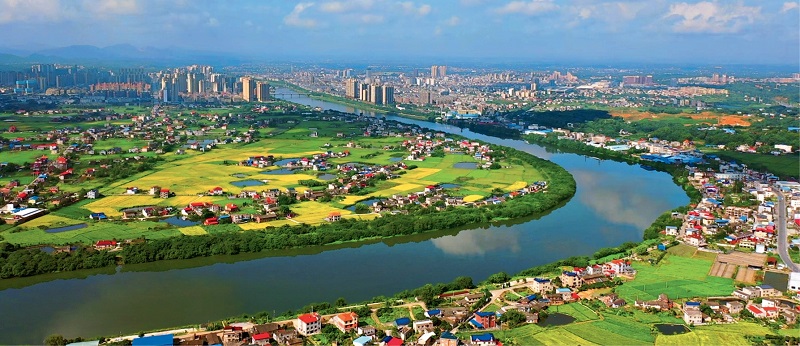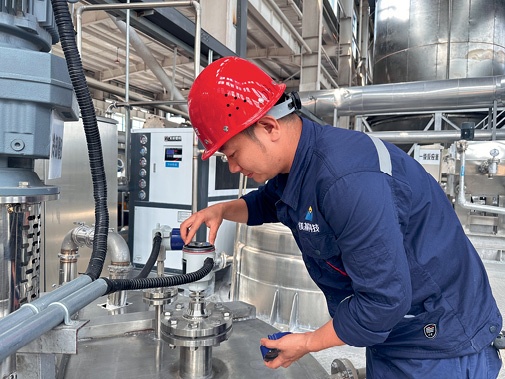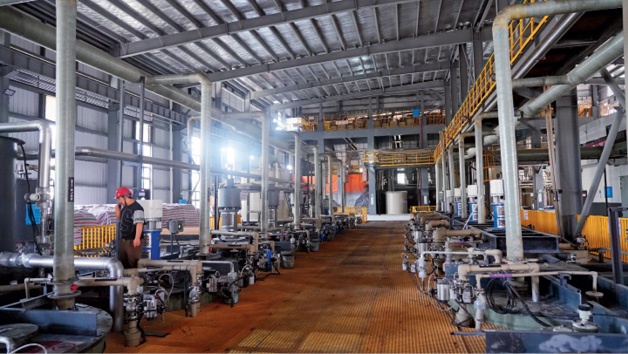A chemical industrial park’s transformation story mirrors a Chinese city’s pursuit of high-quality development.

A panoramic view of Xiangxiang City in Hunan Province.
“Transformation is not simply about shutting down; it is more about eliminating outdated production capacity while nurturing new driving forces,” according to Wan Qian, a member of the Standing Committee of the Xiangxiang Municipal Party Committee, referring to an eco-friendly chemical industrial park in Xiangxiang City, central China’s Hunan Province.
Inside the chemical industrial park, intelligent production lines were at work with a stable output of brine for the production of 20,000 tons of lithium carbonate annually. In the central control room, technicians were focused on monitoring the equipment’s operational parameters; fault warning and remote monitoring were realized through an integrated intelligent control system.
Xiangxiang City, once a glorious industrial hub during China’s first Five-Year Plan (1953-1957) and second Five-Year Plan (1958-1962) periods, has undergone an eight-year-long green transformation before it began to bloom anew.

Hunan Yuneng Recycling Technology Company is a leading enterprise in the global lithium iron phosphate market.
New Undertaking
“For a long time, the old factory was overgrown with weeds, and machines were covered in thick dust. Workers often gathered together, anxious about the future,” said Li Jianguo, a retiree of the former Hunan Ferroalloy Works. Reflecting on the past, he was filled with nostalgia.
As a chemical industrial base established during the 1950s, the small city of Xiangxiang boasted key state-owned enterprises such as Hunan Nonferrous Metals, Xiangxiang Fluorochemical, Xiangtan Alkali Industry, and Hunan Ferroalloy. At its peak, the output value of the local chemical industry accounted for over 60 percent of the city’s total industrial output value, making it a national tech leader in the fields of fluorine chemicals, salt chemicals, and metallurgy.
However, with changes in market supply and demand, several traditional enterprises gradually began to fall into a vicious cycle of “environmental regulation–capacity shrinkage–job loss.” In 2016, companies such as Xiangxiang Fluorochemical and Xiangtan Alkali Industry closed down production for the sake of environmental their protection, leading to a drastic decline in the city’s industrial output value. As a result, thousands of workers were faced with job reassignment challenges. The city stood at a crossroads of transformation.
In response, a special working group was set up to seek a way out. The solution called for tech reforms for 34 high energy-consuming enterprises – pushing 12 of them to acquire green certification while repurposing idle land and factories. In the end, 450,000 square meters of idle factories were turned into space for enterprises to resume work and production.
In 2023, Xiangxiang Green Chemical Park was officially approved, kicking off another journey of entrepreneurship in this land.
According to Wan Qian, through integrating into a new energy industry chain in the near Changsha-Zhuzhou-Xiangtan region, the chemical park has established two core focuses: lithium battery materials for energy storage and fluorine salt chemicals for fine chemicals, hoping to upgrade its traditional chemical industry to the new energy and new materials industry.

Hunan Magic Technology Co., Ltd. has established a production line for the research and development of magnesium-based materials with an annual capacity of 50,000 tons.
A Great Leap Forward
As a leading enterprise in the global lithium iron phosphate market with over 30 percent market share, Hunan Yuneng Recycling Technology Company was established in Xiangxiang in 2022, creating 600 jobs while also attracting upstream and downstream companies, forming a complete industrial chain of lithium ore processing, cathode materials, energy storage applications, and battery recycling.
“We chose this city not only because of its mature chemical industry foundation, but also because of the efficiency of its government.” Wang Haibo, deputy general manager of Hunan Yuneng, explained that it took only 18 months from signing contracts to hitting production. The local government not only coordinated land approval and environmental assessment procedures but also proactively constructed a sewage treatment plant and hazardous waste treatment center, saving their company nearly RMB 10 million.
Leveraging the local resource of dolomite, the city has introduced Hunan Magic Technology Co., Ltd. which has established a production line for the research and development of magnesium-based materials with an annual capacity of 50,000 tons. Its antimicrobial magnesium-based materials have already been applied in the medical field.
“After purification, separation, and calcination, dolomite can be processed into high-purity magnesium oxide, which is widely used in fields such as flame retardants and ceramics,” explained General Manager Li Zhijun. Through the establishment of a joint laboratory with Central South University, the company now commercializes an average of 30 scientific and technological achievements annually.
Currently, the development pattern of the eco-friendly chemical industrial park in Xiangxiang, dominated by new energy materials and multi-chain integration, is becoming increasingly clear. In 2024, its total income from technology, processing, and trade grew by 10.98 percent year on year, becoming a core engine for local high-quality development.
New Momentum
“From project negotiations to equipment installation, each stage is followed up by a professional team from the government. Xiangxiang’s business environment has instilled confidence in innovative enterprises,” remarked Peng Ning, general manager of Hunan Yijia New Material.
Enterprises here can enjoy efficient services from land approval, environmental impact assessment guidance, tailored renovation of power facilities, to organized recruitment of skilled workers. The local government provides thoughtful services to optimize the business environment for investors.
During the construction of a new energy battery project of Hunan Yuneng Company, faced with a daily water demand of a thousand tons, a local water company completed the necessary procedures required for the installation of water meters within 24 hours, providing technical support throughout.
Through the reform of “streamlining administration, delegating power, and upgrading services,” newly established enterprises in the city are now able to obtain a business license within one hour. There’s also a financial advisory system customizing financing plans for enterprises. Besides, a talent programs have cumulatively introduced 110 high-level entrepreneurs and professionals.
In response to the financing challenges faced by small and medium-sized enterprises, the local government has collaborated with banks to launch “green credit” products, issuing low-interest loans exceeding RMB 1 billion in total. In terms of talent support, the chemical industrial park has signed cooperation agreements with universities such as Central South University and Xiangtan University to cultivate technical professionals in a targeted manner, and one postdoctoral work station has also been established.
Currently, the park has implemented nine projects, among which four enterprises achieved a year-on-year output value growth of 10.98 percent during the first half of this year. As is planned, the park is expected to be an industrial cluster of over RMB 10 billion production value by 2027, with new energy materials, fluorochemical, and magnesium-based materials accounting for more than 80 percent.
“From old factories to an intelligent, green industrial park, the transformation process embodies what high-quality development is,” Xiangxiang Municipal Party Secretary Zhao Xinwen summarized. According to him, the city will continue pushing green transformation, turning itself from a traditional industrial base into a modern, new industrial city. 
GUO ZHIQIANG is a reporter with China Economic Weekly.